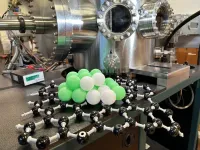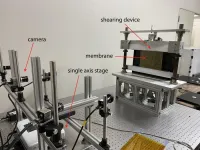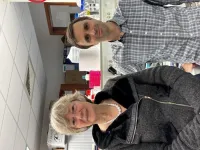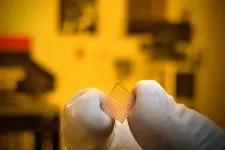(Press-News.org)
Scientists have created a catalyst for hydrogen generation from ammonia that becomes more active with time, and by counting atoms revealed changes that boost the catalyst’s performance.
A research team from the University of Nottingham's School of Chemistry, in collaboration with the University of Birmingham and Cardiff University, has developed a novel material consisting of nanosized ruthenium (Ru) clusters anchored on graphitized carbon. These Ru nanoclusters react with ammonia molecules, catalysing splitting ammonia into hydrogen and nitrogen—an essential step toward green hydrogen production. This groundbreaking research is published in Chemical Science, the flagship journal of the Royal Society of Chemistry.
With its high volumetric energy density, ammonia holds promise as a zero-carbon energy carrier that could drive a sustainable new economy in the near future. Finding fast and energy-efficient methods to crack ammonia into hydrogen (H₂) and nitrogen (N₂) on demand is essential. While catalyst deactivation is common, it is rare for a catalyst to become more active with use. Therefore, understanding the atomic-level mechanisms behind changes in the catalyst activity is critical for designing the next generation of heterogeneous catalysts.
Dr Jesum Alves Fernandes, an Associate Professor in the School of Chemistry, University of Nottingham, and co-leader of the research team, explained: “Traditional catalysts consist of nanoparticles, with most atoms inaccessible for reactions. Our approach starts with individual atoms that self-assemble into clusters of a desired size. Therefore, we can halt the growth of the clusters when their footprints reach 2-3 nm-squared, ensuring that the majority of atoms remain on the surface and available for chemical reactions. In this work, we harnessed this approach to grow ruthenium nanoclusters from atoms directly in a carbon support.”
The researchers employed magnetron sputtering to generate a flux of metal atoms for constructing the catalyst. This solvent- and reagent-free technique enables the fabrication of a clean, highly active catalyst. By maximizing the catalyst's surface area, this method ensures the most efficient use of rare elements like ruthenium (Ru).
Dr. Yifan Chen, a Research Fellow at the University of Nottingham's School of Chemistry, said: “We were surprised to discover that the activity of Ru nanoclusters on carbon actually increases over time, which defies deactivation processes typically taking place for catalysts during their usage. This exciting finding cannot be explained through traditional analysis methods, and so we developed a microscopy approach to count the atoms in each nanocluster of the catalyst through different stages of the reaction using scanning transmission electron microscopy. We revealed a series of subtle yet significant atomic-level transformations.”
Researchers discovered that ruthenium atoms initially disordered on the carbon surface rearrange into truncated nano-pyramids with stepped edges. The nano-pyramids demonstrate remarkable stability over several hours during the reaction at high temperatures. They continuously evolve to maximize the density of active sites, thereby enhancing hydrogen production from ammonia. This behaviour explains the unique self-improving characteristics of the catalyst.
Professor Andrei Khlobystov, School of Chemistry, University of Nottingham, said: “This discovery sets a new direction in catalyst design by showcasing a stable, self-improving system for hydrogen generation from ammonia as a green energy source. We anticipate this breakthrough will contribute significantly to sustainable energy technologies, supporting the transition to a zero-carbon future.”
This invention marks a major advancement in understanding the atomistic mechanisms of heterogeneous catalysis for hydrogen production. It paves the way for developing highly active, stable catalysts that use rare metals sustainably by precisely controlling catalyst structures at the nanoscale.
The University of Nottingham is dedicated to championing green and sustainable technologies. The Zero Carbon Cluster has been recently launched in the East Midlands to accelerate the development and deployment of innovation in green industries and advanced manufacturing.
This work is funded by the EPSRC Programme Grant ‘Metal atoms on surfaces and interfaces (MASI) for sustainable future’ www.masi.ac.uk which is set to develop catalyst materials for the conversion of three key molecules - carbon dioxide, hydrogen and ammonia – crucially important for economy and environment. MASI catalysts are made in an atom-efficient way to ensure sustainable use of chemical elements without depleting supplies of rare elements and making most of the earth's abundant elements, such as carbon and base metals.
END
Exiting Earth’s gravity takes an enormous amount of fuel and power. Due to this, spacecraft strapped to rockets are limited in their carry capacity and every gram must be accounted for. To lighten the load, thin membranes are being researched as alternative materials, but their plastic wrap property causes wrinkling that can affect operational performance. For this reason, there is a need to develop measurement technology that can accurately detect deformations.
Professor Takashi Iwasa at Osaka Metropolitan University’s Graduate School of Engineering led a team in developing a method for measuring the size of wrinkles ...
Women are less likely to receive a lung transplant and spend an average of six weeks longer on the waiting list, according to a study published today (Thursday) in ERJ Open Research [1]. However, women who receive a lung transplant are more likely than men to live for five years post-transplant. Based on their findings, the researchers encourage changes in regulation and clinical guidelines to address this inequality.
Lung transplantation is the only treatment for people with end-stage respiratory failure and patients on the waiting list have a high risk ...
The average life expectancy of people diagnosed with dementia ranges from 9 years at age 60 to 4.5 years at age 85 for women and from 6.5 to just over 2 years, respectively, in men, finds a systematic review of the latest evidence in The BMJ today.
The results also suggest that one third of people with dementia are admitted to a nursing home within three years of diagnosis.
Nearly 10 million people worldwide receive a diagnosis of dementia every year, but survival estimates vary widely, and few ...
UK supermarket giant Tesco is being urged to drop an “unethical” pilot of an in-store infant feeding advice service in which Danone-funded midwives are expected to wear branded uniforms and undergo training by the formula company, reveals an exclusive news report published by The BMJ today.
Critics say that the initiative, running in Tesco’s flagship store and set to be rolled out shortly, is a backward step and reminiscent of the “milk nurses” scandal of the 1970s, where formula industry salespeople dressed as nurses and promoted formula milk to parents.
One midwife hired by Danone quit ...
Unraveling the Events Leading to Multiple Sex Chromosomes Using an Echidna Genome Sequence
A nearly gapless genome sequence of the echidna, an egg-laying mammal with multiple sex chromosomes, helps researchers to track genomic reorganization events that gave rise to a highly unusual sex determination system.
The short-beaked echidna (Tachyglossus aculeatus) is one of Australia’s most iconic animals. Belonging to a unique group of mammals called “monotremes” (with the platypus as the other prominent member). Echidnas may at first glance be mistaken for a weird-looking hedgehog, ...
A new study led by Winship Cancer Institute of Emory University and Abramson Cancer Center of University of Pennsylvania researchers demonstrates that a first-of-its-kind platform using artificial intelligence (AI) could help clinicians and patients assess whether and how much an individual patient may benefit from a particular therapy being tested in a clinical trial. This AI platform can help with making informed treatment decisions, understanding the expected benefits of novel therapies and planning ...
The melding of visual information (microscopic and X-ray images, CT and MRI scans, for example) with text (exam notes, communications between physicians of varying specialties) is a key component of cancer care. But while artificial intelligence helps doctors review images and home in on disease-associated anomalies like abnormally shaped cells, it’s been difficult to develop computerized models that can incorporate multiple types of data.
Now researchers at Stanford Medicine have developed an AI model able to incorporate visual ...
As computer chips continue to get smaller and more complex, the ultrathin metallic wires that carry electrical signals within these chips have become a weak link. Standard metal wires get worse at conducting electricity as they get thinner, ultimately limiting the size, efficiency, and performance of nanoscale electronics.
In a paper published Jan. 3 in Science, Stanford researchers show that niobium phosphide can conduct electricity better than copper in films that are only a few atoms thick. Moreover, these films can be created and deposited at sufficiently low temperatures to be compatible with modern computer ...
Chestnut Hill, Mass (01/08/2025) – Nations must start testing and regulating chemicals and chemical products as closely as the current systems that safeguard prescription drugs or risk rising rates of chronic illnesses among children, according to a New England Journal of Medicine report by a group of experts writing as the Consortium for Children’s Environmental Health.
Global chemical inventories contain an estimated 350,000 products – such as manufactured chemicals, chemical ...
FOR IMMEDIATE RELEASE
Media Contact: Levi.Gadye@ucsf.edu, (415) 502-6397
Subscribe to UCSF News
The discovery of a new type of stem cell in the brain could usher in better treatments for the deadliest brain tumor.
UCSF scientists have discovered a stem cell in the young brain that’s capable of forming the cells found in tumors. The breakthrough could explain how adult brain cells take advantage of developmental processes to instigate the explosive growth seen in deadly brain cancers like glioblastoma.
They made the discovery while taking a broad genomic survey of human brain ...




